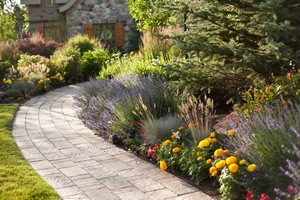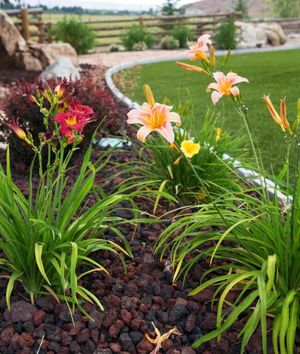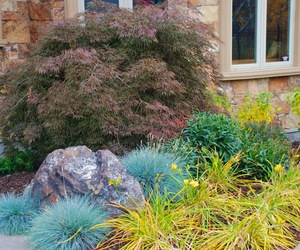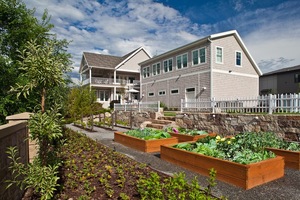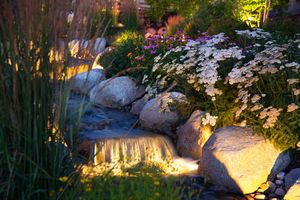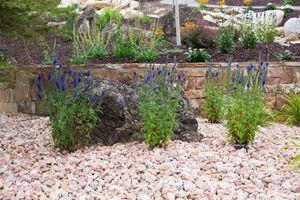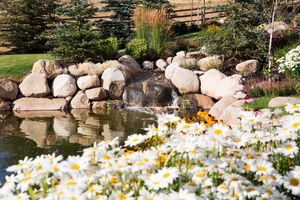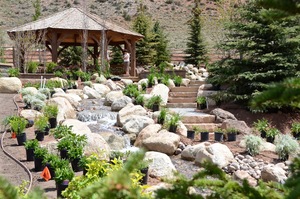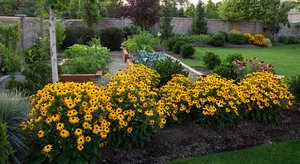We take a personal interest in the quality and the establishment of your plant material. Our Salt Lake City area tree and plant landscaping contractors have developed a green thumb over the years and we have provided many beautiful garden landscaping designs to Pleasant Grove, Park City and all of Utah. We have hand-selected specific growers to ensure that we receive their best material and handle all plant material carefully and have special processes that we follow to ensure the success of everything we plant.
Plants and trees are living organisms that need care and attention in order to thrive. This section will describe what we do for you and what you will need to do for your landscape to thrive.
As part of our garden landscaping design process we plant your trees and plants top of the root ball so that it peaks above the grade. If the root ball is too low, the trunk suffocates and tends to pool up with water. We leave the canvas sack and wire mesh around the root ball to keep everything intact. Attempting to remove any of that would damage the roots severely.
The first months are critical as the material is in a state of transplant shock. Our Pleasant Grove garden landscaping design experts will do everything they can to minimize this shock and move the material toward immediate growth.
Upon planting, everything is deep soaked and thoroughly watered. We stake major trees to ensure that they grow straight and that the root balls do not move (we remove the stakes after 12 months). Any root movement tends to disrupt the tiny new growth and create further shock. We have invested in a transplant fertilizer system that we perform immediately after planting. Finally, we observe a project for the first 3 weeks to keep a close eye on all material.
A major reason for material shock is too much water and extreme conditions such as high heat and high winds that sometimes plague less experienced Salt Lake City garden landscaping companies. When these things occur, the leaves will start to droop and dry out. This is the way that the plant/tree saves all nutrients to the core. If the conditions are resolved, the plant/tree may promote new growth within the same season. Otherwise, it will happen the following spring. Please let us know if any of your material is struggling so that we can offer recommendations. This is one area that you will need to pay close attention to at first!
A common tendency is to apply more water to material when it is struggling. Before doing that, check to see how wet the soil is. If the soil is soggy, that is a primary indicator that the material is too wet and needs to dry out. You will be surprised how quickly the material bounces back when it dries out.
FLOWER BEDS
TOPDRESSING TOUCH-UP
Most of the time, we install some type of a top dressing in flower beds. This type of landscaping makes your garden look more finished and can protect your plants and trees. This dressing looks nice for awhile, but over time, it will need to be replaced.
The most common top-dressings are:
-
Shredded bark
-
Bark fines which are tinier and decompose into the soil
-
A rich topsoil
-
Gravel or rock
In terms of replacement, rock has the longest life cycle. Topsoil can be raked out and made to look new. Bark fines are light and in windy areas, tend to blow out and therefore need to be replenished. Shredded bark discolors due to the heat and water and is usually replaced every 2-3 years.
To maintain the appearance of the top-dressing, we recommend carefully raking out the flower-beds and turning over the old product and exposing fresher bark or topsoil.
When it comes time to replace your bark, Platinum Landscape is one of the most experienced plant landscapers in the Salt Lake City area. Feel free to call us for an estimate.
WEEDING
This is something that every homeowner that cares about their plants and garden in Pleasant Grove and really anywhere in Utah has to deal with and hates. We have several landscaping recommendations Salt Lake City area garden designs to help ease this burden.
With weeding, the key is to get on top of it early and then manage it. If you let it get out of hand, then it becomes a chore.
At the beginning of the season, apply a pre-emergent to the lawn and to all flower-beds. If done early enough, the pre-emergent kills the dormant weed seeds. Topdressing also helps to minimize weed growth as it is not dense enough for the weeds to grow in.
During the season, when weeds begin to appear, get to them quickly. The easiest way is to buy a product like RoundUp and just spray the weed. The solution only kills what it touches so be careful not to spray any plants that you want to save. This should take no more than one hour per month if you stay on top.
Read the instructions regarding application. If it is windy, rainy or too hot, the application is ineffective.
PRUNING
As a general rule of thumb, proper pruning is critical for tree and plant landscaping to promote growth and health of the plant. While there are different schools of thought, pruning is best done in the late fall or early spring. Once the material has lost the leaves, you can prune back the branches.
On most plants, a good pruning will promote rapid new growth in the spring creating a healthier plant. You might notice that certain branches have died and those can be cut out during the season to create a healthier looking plant.
Some plant material is used to create more formal looks or a hedge and seasonal pruning would be required to maintain the shape.
Pruning trees can be a little more strategic and we recommend doing some reading or attending a class on proper pruning techniques. Our landscaping company can also give you advice on pruning trees and plants in their Salt Lake City gardens.
FERTILIZATION
Fertilization plays an important role in landscaping design and helps promote your garden’s vitality. We recommend that your material is fertilized at least once a year in the spring. You can spend a lot of money having someone else do this. It is very easy and does not take a lot of time.
We recommend a granular application (the same you put on your grass). The best formula is an even blend of 18-18-18 or 18-10-10. Simply take a handful and spread evenly around the root ball. Make sure that the fertilizer does not rest on any foliage or it will burn (gently shake the material to remove any granules that might be on the leaves or branches). After everything has been fertilized, water in the fertilizer and watch for the new growth.
